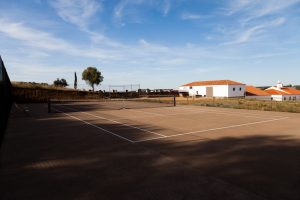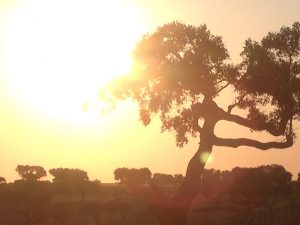Ask any Portuguese person to name their favourite wine, and nine times out of ten they’ll point to an Alentejo vintage. The Alentejo region is the largest in Portugal, accounting for almost a third of the country, yet only 5% of the population. It produces half of all Portugal’s wine, and, not coincidentally, half the world’s supply of cork.
If you were to drive or take the train through it, which I have a few times, you’d be forgiven for thinking it wasn’t much else except mile upon mile of honey-coloured plains, cork trees (sobreiros), and wheat fields – an unfolding scene reminiscent of a Van Gogh painting. But look a little closer and you’ll find world-class vineyards, modern art galleries, Neolithic stone circles, Roman ruins, castles and palaces.
Alentejo literally means “beyond the Tejo river”, and the region is divided into the Alto (upper) Alentejo and Baixo (lower), plus the Ribatejo – the area east of Lisbon. Two of its main towns – Evora and Elvas – have UNESCO World Heritage status.
In summer, temperatures can reach a scorching 45 degrees, leaving the land looking almost desert-like. But winters can be cool. It’s precisely this climate, and the harsh, schist-based soil, that creates the perfect conditions for winemaking.
What makes Alentejan viticulture so special is that it uses local grape varieties. Antão Vaz, Arinto, Trincadeira and Aragonês are combined to create a unique, and incredibly delicious product.
So a tour of the vineyards is almost compulsory. You’ll have to draw straws for who’ll be the designated driver because these properties are far and wide apart, and the buses and trains that ply the middle hardly touch the good stuff. But thankfully, many also operate as wonderful boutique hotels, much like the agroturismos in Italy, so you can spend the night (or a week) in each one after you’ve sampled the produce.





At Herdade do Vau, an old country house-turned-wine hotel, close to the Guadiana river, a ‘bio chic’ aesthetic, remote location and fine wines draw visitors from all over the world. At Quinta do Quetzal, it’s more about the art. A sleek white building on the slopes of Vidigueira, the lower floor is given over to installations from internationally acclaimed artists, while upstairs is for dining, wine-tastings and petiscos (Portuguese tapas) overlooking the vineyards. Owned by the De Bruin-Heijn family (Inge de Bruin-Heijn was a consultant for the MoMA in New York, as well as art director of Art Basel) it successfully combines contemporary art with rural life.



At the beautiful Herdade da Malhadinha – a boutique hotel and wine estate between Beja and Castro Verde – it’s more about the relaxation. Rita Soares and her family have converted an old homestead into an exquisite retreat, spanning some 600 hectares. As well as impressive food and wine, there’s an infinity pool overlooking the fields, a spa, and the opportunity to take a sunrise hot-air balloon ride, or ride out on one of the farm’s Lusitano horses.
Dinner is a feast of local produce – organic gazpacho, local fish carpaccio, black pork in rosemary sauce, organic honey and peach sorbet, and homemade olive oil, accompanied by some of the estate’s award-winning wines, such as the delicious Monte da Peceguina and the Late Harvest.
On to Borba, and to the fabulous Casa do Terreiro do Poço, a historic house owned by two local antiques dealers, Rita and João Cavaleiro Ferreira. Its 14 rooms and suites are decked out in collectables from the the couple’s travels – tapestries, vintage valises, opulent rugs and mirrors. Such a unique place is a breath of fresh air for those used to homogenous corporate chains.




Nearby is the walled city of Estremoz – famous for its Saturday market, as well as its marble – and we dine at the wonderful Mercearia Gadanha. Dubbed the “breadbasket of Portugal”, the Alentejo is a place of earthy cuisine – black pork, wild mushrooms, asparagus and sheep’s cheese – but newer restaurants are reviving these ingredients, giving them a contemporary spin. The menu at Mercearia Gadanha serves dishes such as black pork cheeks, mushroom croquettes, quail’s eggs and grilled goat’s cheese with thyme ice-cream, and the desserts would make Willy Wonka weep for joy.
The following day we visit the walled hilltop village of Monsaraz, one of the country’s oldest settlements. The old primary school here has been turned into a wine shop – Adega Ervideira – and the girl who works there is a former pupil. She lets us sample their most popular wines – a white made from red Aragonês grapes – aptly named Invisivel – and a ‘water wine’, aged in bottles at the bottom of the Alqueva dam (the largest artificial lake in Portugal), to emulate the quality of vintages found in shipwrecks.




And so to the dam itself. After a fabulous lunch at Amieira Marina, overlooking the glistening shores, we take a boat out to explore the interior. In so many other countries I can think of this lake would be overrun with leisure tourists and local weekenders on yachts, waterskis, SUPs and a plethora of other flotation devices. Yet here we have it all to ourselves. To not jump in for a swim would be criminal, so that’s exactly what we did. Cruising through the water with the sun on our backs, not a soul in sight, I’m reminded exactly why I love it here and will keep coming back for more.
For more information, please visit www.visitalentejo.pt and www.visitportugal.com. TAP Portugal flies direct from London City, Heathrow, Gatwick and Manchester to Lisbon up to 12 times a day, prices start at £42 one way, including all taxes and surcharges. Visit www.flytap.com or call 0345 601 0932.


[…] you might also like to take a look at my review of the new Bless Hotel in Madrid, read my story on wine-tasting in Portugal’s Alentejo region, and check out this wine-tasting trip to […]
I lived in Lisbon for a couple of years and heading down into the Alentejo, which did not take long, was always rewarding. The region’s hearty cuisine as well as its red wine were among the reasons I enjoyed visiting.
Ah, yes! The red wine and hearty food is some of the best! I shall be back for sure.